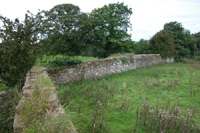Fountain Abbey: Precinct
The monastic precinct at Fountains was remarkably extensive, covering some seventy acres. Even by Cistercian standards this was large: Kirkstall’s precinct was about forty acres and Roche’s about thirty acres. Rievaulx, however, spanned over ninety acres. The entire precinct at Fountains was enclosed by a wall, which was built in the first half of the thirteenth century. This stood almost 3.5 metres high and remains standing to the south and west of the abbey.(1)
|
The slaughter-house Read more about the tannery at Fountains |
The Fountains precinct was bisected by the River Skell and comprised of three zones. The church and claustral buildings stood at the centre of the precinct where they were sheltered from the hustle and bustle of all the activity. This meant that the monks could carry out their spiritual observances in relative peace and tranquillity. An inner court housed domestic buildings including workshops for the tailors and other craftsmen. Industrial and agricultural work was carried out in the outer court, which lay to the south of the river. Two remarkable buildings in the outer court, the corn-mill and the wool-house, have survived and can be visited today. Other buildings here would have included the tanneries, granaries and even a slaughter-house, as well as orchards, bridges, ponds and pastures. The precise layout and nature of work carried out here, however, remains largely unknown. The function and structure of the precinct was adapted throughout the Middle Ages, in accordance with the community’s needs.
Fountains’ precinct was bordered by the abbey’s home granges, which directly served the community. Swanley and Morker could be accessed from the outer court of the monastery via a gate, a reflection of their close connection with daily monastic life.(2)
References
1. G. Coppack, Fountains Abbey: the Cistercians in Northern England (Stroud, 2003), pp. 79-81.
2. G. Coppack, ‘The interface between estate and monastery’, in L’Espace Cistercien, ed. L. Pressouyre (Paris, 1994), pp. 415-425, at p. 419.
